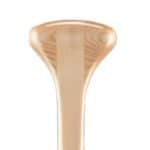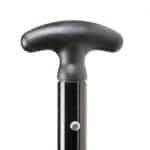Choosing a paddle is personal. It’s based on your preferences and stature, and in the end, it’s in your hands, plying the water, thousands of times a day.
The first thing to consider is how you’ll use your paddle. Whether you’re out for day-trips or an Arctic expedition, cruising down a creek or crossing Michigan’s Sylvania Wilderness, there are paddles built for each use. Many advanced canoeists own multiple paddles suited to the various conditions they encounter. Once you’ve decided how you’ll use your paddle, you’re faced with a wide variety of designs, materials, and lengths. Design features, like length and width, play a big role in determining how a paddle performs. Material is largely a matter of personal preference. Length is how paddles are sized. Regardless of what type of paddle you decide upon, it’s important to make sure it fits to prevent injury and discomfort.
The best paddles maxmize efficiency so you don’t waste effort in splashing water, dragging it through the air, or keeping it steady. Some paddles are efficient because they are lightweight, and thus easy to use over long-distances. Other paddles efficiently move lots of water in one stroke for quick maneuvers. The goal is to find one with the balance of strength, weight, and power that’s right for you, every stroke of the way.
USES:
The Canoeing.com Guide to Paddles is organized by how paddles are best used. If you spend a couple weeks each summer traversing Canadian lakes, then one of the lighter weight, durable Wilderness Tripping/’Freestyle’ Paddles could suit your needs. Modeled after traditional designs with long, slender blades, these paddles are built for efficient flat-water paddling over long distances, ideal for widlerness canoe tripping. These paddles are also preferred for the elegant movements of Canadian ‘Freestyle’ paddling. Descending rivers or shallow streams often requires a River/Whitewater Paddle that is both extremely tough and powerful. Their shorter, wider, square blades with a stiffer flex make them more efficient for the quick, strong strokes required in whitewater. For day-trips on local waterways a low-maintenance recreational paddle made of plastic or softwoods may be all you need. Recreational Paddles typically have shorter, wider blades that can be used in a wide-variety of situations. The recreational or racing paddler may also appreciate one of the Bent-shaft Paddles that are designed with a bend to provide power and paddling efficiency by using shorter, faster strokes. If you’re taking kids out canoeing, it’s a good idea to look for Youth Paddles that are scaled down to fit their smaller hands and stature. Or, if you’re headed out alone, you might prefer one of the Double-bladed Paddles, similar to kayak paddles, to provide efficiency and maneuverability in a solo canoe.
PADDLE TYPES BY USE:
Wilderness Tripping/’Freestyle’
Modeled after the classical designs like the ottertail, beavertail, voyageur and Algonquin; these paddles feature long, slender blades, ideal for long trips when paddling from dawn until dusk or for days-on-end. And, if you’re looking for that paddle best suited for the Canadian ‘freestyle’ paddling stokes you will find them in this section. Shop Tripping Paddles
River/Whitewater
Designed with shorter, wider and stiffer blades. These paddles respond to the quick power maneuvers required when paddling fast water and whitewater conditions of rivers and streams. Blade styles include; beavertail, Sugar-island, and whitewater. Shop Whitewater Paddles
Recreational
Designed with recreational use in mind, the features of these paddle blades include stiffer flex to increase stroke efficiency, with a shorter, wider blade and shapes like the beavertail, Sugar-island, and the squared-off whitewater style. These paddles offer the widest range of canoeing applications from a single paddle. Shop Recreational Paddles
Racing/Bent-Shaft
Designed with a bent shaft to provide power and paddling efficiency by using shorter strokes and increasing stroke-rates. These paddles are ideal for racing but can be fun for recreational use as well. The blade styles include Sugar-island, whitewater and squared-off versions of both styles.
Youth
Scaled down versions of their adult-sized counterparts, these paddles are designed with kids in mind. They are shorter with smaller blades, lightweight, balanced and durable. Shop Youth Paddles
Solo/Double-bladed
Designed for solo ‘play’ and whitewater paddling. These paddles are similar to the double-bladed kayak styles but manufactured in shorter lengths with narrow, symmetrical blades keeping the solo canoeists in mind. Shop Solo Paddles
DESIGN:
Canoe paddles, though all based on the same shape, vary in specific and meaningful ways. Let’s start with the basic anatomy of a paddle.
Blade
The most prominent part of the paddle is the blade. This is also the part where variations are most clearly seen. The power of the blade is based on area, which typically falls between 125 and 165 square inches. Although a bigger blade is more powerful, it is not always better. A smaller blade face is less tiring, and thus preferred by marathon racers who depend more on quick strokes for speed. When maneuvering is important, like in whitewater or slalom canoeing, a bigger blade face is advantageous, though it can be tiring over long-distances. The main distinction in blade shape is between long, narrow blades and short, wide blades.
A long, narrow blade is easier to keep close to the canoe (so less steering correction is needed), has a quieter entry into the water, and has a lot of power in deep water. These paddles are excellent for long-distance flat-water paddling because they are lightweight and provide terrific control. They are modeled after the traditional paddles used by the Fur Trade Voyageurs and many Native American designs. They don’t work well in shallow water however, because much of the blade face is left cutting through air instead of water.
A short, wide blade is great for paddling on rivers, where you’re likely to encounter rocks and shallow water. Not only are you less likely to hit bottom, but the wider tip resists impacts slightly better. Area for area a shorter, wider blade is a more efficient shape, transmitting more power per stroke, but the trade-off is that they don’t enter and exit the water as smoothly. This shape is common for recreational paddles in part because it is a bit easier to handle, since you don’t have to lift so high between strokes.
Technical whitewater paddlers may want to consider a paddle with a spoon blade. These paddles grab lots of water, providing lots of power, but their asymmetry means they only pull well in one direction. They are a bit excessive for flatwater paddling and aren’t necessary for easy whitewater, but if you’re tackling bigger rapids you might want to consider the added thrust provided by a spoon blade.
Tip
Paddles can have either a square or a rounded tip. A round tip is slightly more stable, while a square tip is slightly more impact resistant. Because they have more area a square tip provides better leverage, and is thus standard on whitewater paddles. Many wood paddles feature tips made of fiberglass or other synthetic materials for greater impact resistance.
Grip
The most important factor in choosing what kind of grip you want is comfort. In terms of fit, a grip that is too big or too small can cause cramping, fatigue, and blisters. Shape also determines how comfortable a grip is. There are many possible shapes, but two predominate: the pear (also called palm) grip and the T-grip. Flatwater paddlers tend to prefer the pear grip because it tucks comfortably into the hand. The T-grip is common on river/whitewater paddles because it allows for a tight hold and excellent control in strong currents. Some grips are asymmetrical, which enables you to flip the paddle around to change the pressure on tired hands.

Palm Grip

T-Grip

Video: Choosing the proper canoe grip at Bending Branches
Shaft
The role of the shaft is to transmit the power you generate to the blade. It is important that it is strong and abrasion resistant so it can withstand getting knocked against the canoe’s gunwales. The shape of a shaft is either round or elliptical. Elliptical shafts have the advantages of being more comfortable and indicating the paddle’s orientation simply by touch.
Canoe paddles are traditionally built with a straight shaft, but since the 1970s they are also available with a bent shaft, and even more recently, with a double-bent shaft. The bent shaft enables more effcient power strokes because the blade stays vertical in the water longer, moving more water backwards and less upwards. They also enter and exit the water more smoothly. The double-bend is structured to ease the stress on the lower wrist. The angle varies from 7 to 14 degrees: a paddle with a smaller angle is capable of a wider variety of strokes, while one with the larger angle makes for the most efficient stroke. Preferred by marathon racers and some flat-water recreational paddlers, these bent shaft paddles are not for everyone. Whitewater paddlers and many stern paddlers favor straight shaft paddles because they provide a longer reach and more maneuverability. Traditionalists also won’t find the classic long, slender shapes paired with a bent shaft.
Finally, like with the grip, it is important that the shaft be neither too small nor too large for your hands. Either extreme will cause unnecessary fatigue and cramping, so as much as possible try out paddles before you buy them to see that they fit your hands appropriately.
MATERIALS:
Wood
Both beautiful and versatile, a variety of woods are used in paddle-making to give paddles different characteristics. Hardwoods, such as ash, maple, basswood, butternut, black willow, and black cherry, are durable and can be feathered to a fine edge. Softwoods, like cedar, pine, and spruce, are lighter and less expensive, but more fragile and bulky. Wood laminate paddles combine hard and softwoods to maximize the best qualities of each for strong, lightweight paddles. Many wood paddles are reinforced by a fiberglass wrap and a plastic or fiberglass tip. Benefits are that wood retains warmth and flexes to absorb shock. From time to time they do require some care, however, like sanding and varnishing to keep them in good condition.
Composite
Composite blades made of fiberglass and carbon are incredibly lightweight, durable, and stiff. Unlike wood, these materials can be molded into extreme curves with knife-edges. Aggressive and rugged, they are a common choice for whitewater paddles, but they do not flex as well as wood and are very expensive.
Plastic
Plastic blades are typically paired with an aluminum shaft and reserved for recreational paddles. It won’t break easily, but it will show wear and tear more than other synthetic materials. Plastic paddles tend to be heavy and inefficient, but are a great inexpensive option for tooling around the local lake or as a spare on an advanced expedition.
FIT:
One of the trickiest parts of paddle selection is determining what size you need. More art than science, it’s based on your physique, the boat you paddle, and your particular style.
To begin with, you want to measure your grip span—the distance between your two hands when gripping the paddle properly. If you have a paddle you like already, you can hold it and measure your grip size from the top of the grip to the bottom of your lower hand. If you don’t have your own paddle already, here are two easy methods for measuring your grip size.
Seat to Nose
Sitting upright in a hard-bottomed chair, get someone to measure the distance from the surface of the seat to your nose. Add another five or six inches to this distance, and the sum is a good estimate of your grip size for a straight shaft paddle. Illustration?
Overhead
Hold a paddle (or broomstick) in both hands overhead, so that your arms form right angles at the elbows. The distance between the top of the grip and the far side of your other hand is another estimate of your grip size.
Now, to determine the overall length you need for a particular paddle, add your grip size to the blade length. For a bent shaft paddle you’ll subtract 2” to 4” from this overall length.
The optimum length depends on your stature primarily, but also on the boat that you paddle. A deep, wide canoe will necessitate a longer paddle. Whether you sit or kneel and the height of the seats will also make a difference. If you paddle one canoe regularly, it’s a good idea to measure your grip span when you’re sitting (or kneeling) in that canoe. You can adjust your paddle fit by allowing for a few inches in the region between your lower hand and the top of the blade. This will enable you to compensate for a canoe that’s wide or has a lot of freeboard. Some stern paddlers and whitewater paddlers also prefer a slightly longer paddle for that little bit of extra reach when maneuvering.
HELPFUL HINTS:
Carry a Spare
It’s a good idea, even on short trips, to carry an extra paddle. If one breaks, gets lost, or is irretrievably forgotten, paddling with an inexpensive spare is far preferable to drifting aimlessly.
Wood Paddle Upkeep
If your paddle has a varnish coat it will periodically need to be sanded and re-varnished. The tip and edges will need more frequent touch-ups, and then occasionally you’ll need to go over the whole blade. First, scrape off loose flakes of varnish around scratches. Sand the whole blade, or whole paddle if you want, with 150-grit sandpaper. Clean off the surface with a damp rag, and apply several coats of spar varnish that contains a UV barrier. Apply subsequent coats within 24 hours of each other so they bond well. Varnishing is tricky to perfect; just try to be consistent to avoid runs, puddles, and dust.
If your paddle has an oil finish, make sure to keep it well oiled. Boiled (not raw) linseed oil and tung oil are both suitable. Wipe the oil on thickly, let it soak in for a couple hours, wipe off the excess and buff the surface. The whole paddle will need to be re-coated at least every three months, but for frequent touch ups on the trail carry a small bottle of oil or, in a pinch, make do with margarine or cooking oil.
Storing Your Paddle
In the wilderness or at home, store your paddle out of the sun to avoid warping, and either hanging (preferable) or flat so that it does not become bowed by leaning against a wall. Keeping the tip off the ground will also prevent grit from working its way into the wood and causing serious damage. Be careful with softwood paddles, particularly, because they tend to fray at the tip and split if they are stepped on.
Frost River Paddle Sack








